We all know that just because a particular vehicle is rare doesn’t always mean that it’s valuable or even desirable. This is one of those cases where rare does equal valuable, and even desirability, at least to those of us who love early Saabs. This rare and desirable car is a 1955 Saab 92B. I know, a 92! They do not come up for sale too often in any condition. This one is listed on eBay with an unmet opening bid of $6,109 and a buy-it-now price of $12,500. It’s located a long way from the US – it’s in Sweden. In Varberg, Sweden, actually, less than two hours south of the historic home of Saab: Trollhättan.
A big difference in the later Saab 92 examples like this one is that they had an outside-opening trunk/boot. The early 92s had a storage space in the rear but it was accessed by removing the rear seat back; not the most convenient way to load up your luggage. The 92 was made starting in late-1949 for the 1950 model year, and they were produced until late-1956. The last year they ran concurrently with the new Saab 93. The seller says that this car was left “in an insurance companys enclosure since december 1969 until 2016 when I bought it, I have restored it to working condition.” This car would be gorgeous if restored back to original-spec.
If all was right with the world this car would already be heading towards our garage, one nautical mile at a time. A few years ago I would have done almost anything for a Saab 96/95/94/93, and especially a Saab 92. When it owned Saab, GM named the Saab 92 as their top car when asked for their top-ten cars. That’s no small feat considering that it was ahead of the Corvette, EV1, and Pontiac GTO. The interior looks like it’s ready to be restored, with all or most of the original fabrics and parts. They had a non-synchro first gear and a top speed of around 65 mph, or 105 kph.
The seller has “restored the cars original parts as much as possible, only bought a few new original saab parts as headgaskets.” There isn’t a lot of rear seat legroom, but you can see that these front seats are positioned all the way back. Speaking of comfort, Saab 92B owners were able to configure the seating into a double bed, for those nights when you’re stuck in a snow drift in Sweden. The seller mentions that they have “welded floors and restored brakes and engine.”
Now that’s an engine! A two-cylinder, two-stroke corn-popper; beautiful. Actually, Saab’s three-cylinder, two stroke was known as a corn popper but these twins have a great sound, too. This one is 764cc worth of pavement-pounding horsepower – 25 hp to be exact. DKW actually had a large role in designing this engine. In 1955, an electric fuel pump was available for the first time, that’s usually quite an upgrade. I can’t imagine that finding parts for a Saab 92B would be easy at all, but man, what a rare car you’d have when it was done!






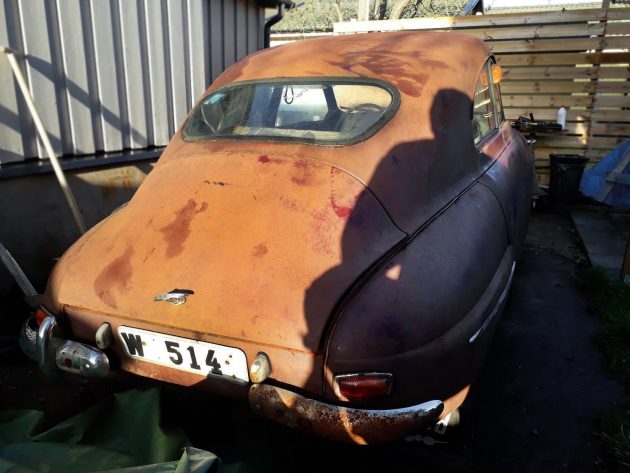
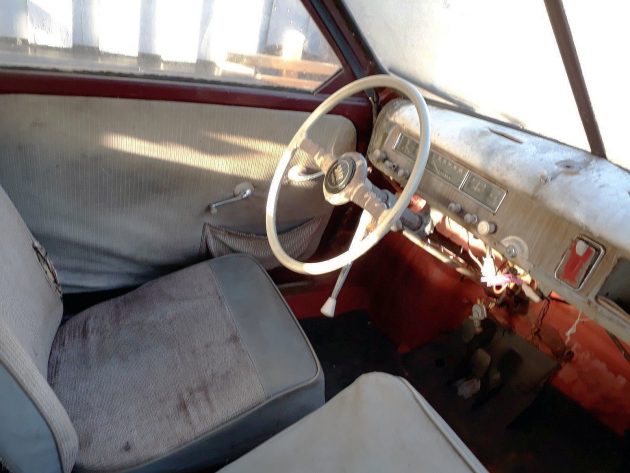
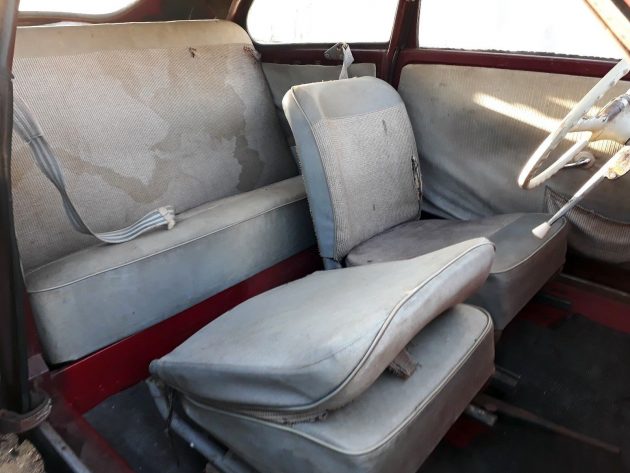
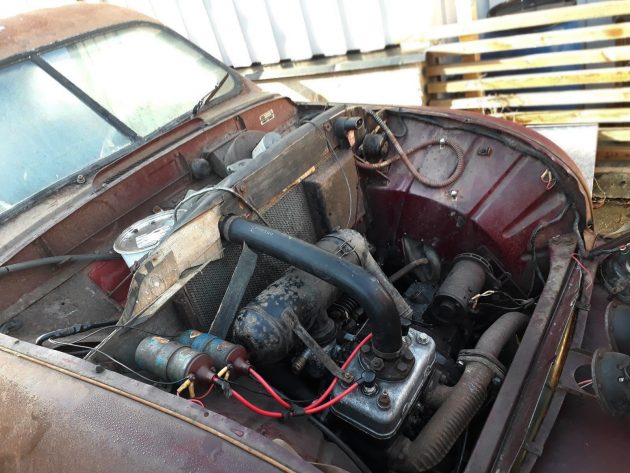
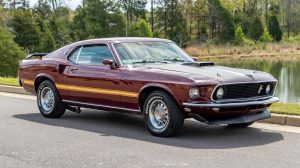
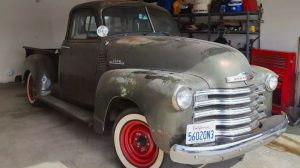
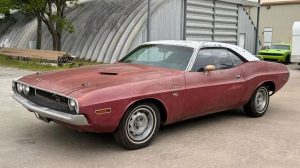
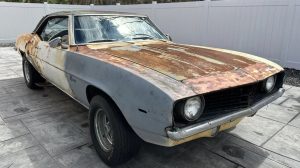


Nice but pricey…
It looks like a big fat caterpillar…
Like !
Wow, this would make for a great restoration.
If it was closer to home, I’d be all over this.
Who sits in that back seat? Oh, Forrest Gump drives while Lt. Dan rides in back.
You sit in the lotus position.
Oh, too soon, Jeffbro! 😉
I can’t see an A/C compressor on the engine.
I can’t imagine that the Swedes would let this one get out of Sweden.
It’s hard to imagine that the Swedes would let this one get out of Sweden.
One of the very 1st cars I drove was a Saab 92 or 93, early 60’s maybe. My parents had friends in Mass. and they had Saabs. It had been sitting and my brother and I got it running and drove it around their big yard. It had the 4 speed on the column, and I remember, the gearshift, which was worn, would go almost half way around the wheel, and a “James Bond” smoke screen behind. It was fun, until we actually rode in it on the road, and found out how gutless it really was. So under powered, with passengers, it wouldn’t hold 4th gear, and they drove around in 3rd. Sorry, I like 2 cycles in certain vehicles, but not in cars. I wonder if an old Saab would even be allowed in California? Interesting find, but the newer 96’s were much nicer cars. I’d love to have a 96, this, not so much.
I was lucky enough to have found a 1963 SAAB 850 G.T. Monte Carlo rallye car, with the 850 cc engine, high compression cylinder head, triple carbs with oil injection, and front wheel disc brakes. Was still equipped with the rallye instrumentation & equipment too. [Halda, Curta calculator, etc.
This car had been one of the European factory sponsored rallye cars, and toured all the SAAB dealers in the USA, ending up in California, where my father’s friend bought it. In 1968 he came to Maryland, and put the car into the garage until he sold it to me. [He bought a new Datsun Z car with A/C, and the dealer had no interest in the SAAB as a trade-in.]
This SAAB could not be caught on curvy back roads. I raced similar era supercars like a Ferrari 250 GT that kept up but never could pass me.
Sadly, this was one of the 16 cars I lost when lightning hit my building in 1996.
Sweet, and wery rare.
In Europe they are very expensive.
Almost no matter condition
James May was driving in a gray one, in a chapter of top Gear.
Sweet ride!!
It wasn’t until after a second glance that I noticed the “suicide” doors. Always a cool design feature when creating a street cruiser. My 1950 Tempo Matador’s roots are from this same era, where suicide doors were incorporated into the production design…
I saw that too, and also the turn signals on the B pillar. I’d think those were pretty rare. I can’t find any images with those. And what’s with the 2 coils?
There’s 2 ignition switches sitting on the sides of the end of the camshaft, the end of the camshaft is “oval” and will hit the switches when the piston is in the correct position to ignite.
The turnsignals is supose to be direction indicator but I guess someone back in the days wanted to be more modern and replaced them with ordinary turnsignals.
Rube, there’s a coil for each cylinder.
DKWs used the same principal, I forgot to mention.
1 coil for each spark plug, 2 sets of points on the crankshaft end, each firing it’s own coil, once per revolution. Ultra simple. No distributor required! Same as on a 3-cyl DKW.
Note that this engine has more in common with the East German Trabant, both are based on the pre-war DKW 2-cylinder engine.
And I thought my grandfathers 1950 Nash was butt ugly! Yikes!
In the pre Highway Safety days, transport companies were responsible for any damage to the cars. Even a simple door ding triggered the clause that made the car the property of the shipper. KAT was primarily American Motors transport, but they also shipped many Euro cars from the old distributor system. I’m guessing it was 1962 when we became the proud owners of one of these. It was literally “thrown in” as my Father was required to buy it to get seven cars with only acid damage from a burst battery. Four speed on the column and a case of two cycle oil in the trunk. It made the 1800 mile trip from Kenosha to Coeur d”Alene on $13.50 of gasoline. I have never checked the math on this as it has been family lore for 56 years. For context, every SAAB dealer we visited trying to sell it had several engines sitting around the service area from owners who forgot the oil part of the gasoline fill-up. It was also my intro to front drive.
Rube, the two-cycle Saabs all had a coil for each cylinder. I am not exactly an authority on automotive electricals, so I can tell you only what they had, not why. Perhaps there is one (or more) among us who can explain it.
It was common for two-stroke multi-cylinder engines to have a separate ignition system for each pot. Have a look at old too-smoke motorcycles and you’ll see the same set up. This allowed for the timing for each cylinder to be adjustable for tuning purposes, rather than relying on a distributor.
“a coil for each cylinder”
..what virtually all new car engines have had since about 1990. Saab was only 40 years ahead of their time in that regard!
Wow! I’m in love with this cute little bug. Would immediately become the wise old man in my Saab Stable!
Back in the early ’60’s I had several 58,59,and 60 Saabs;usually bought very cheaply due to seized motors from forgetful owners.I discovered that a brand new engine from Saab cost only $150,and required about an hour and a half to swap over.We used to call them “single overhead fan shaft” engines, since the radiator was up against the firewall, and cooled by a rear facing fan attached atop the cylinder head.My greatest coup was swapping my 1960 Saab even up for a ’61 Alfa Giulietta Sprint Veloce with high mileage!
I am not much of a Saab fan. ( I had one once as a company car (a’99 EMS) and was not impressed.) But think how one of these would go with one of the current HP snow mobile engines installed. I doubt the gear box would like it much!